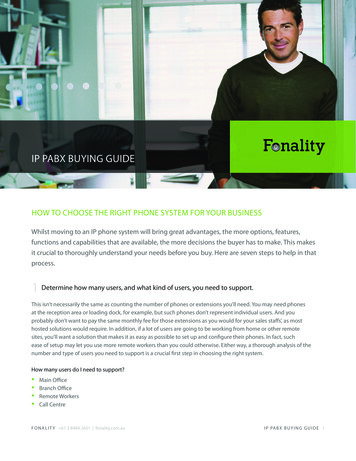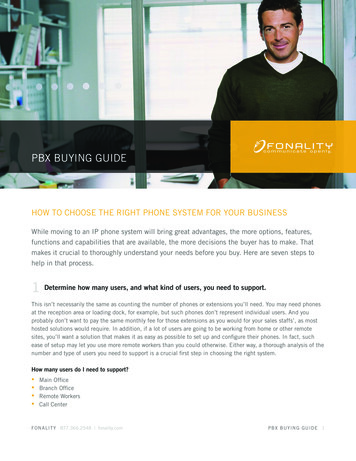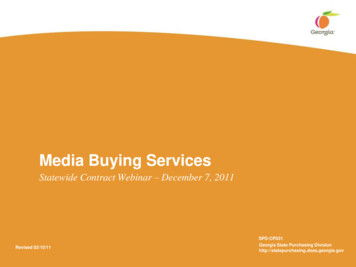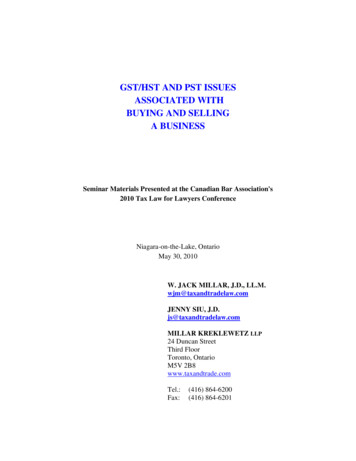
Transcription
IP PABX BUYING GUIDEIP PABX BUYING GUIDEHOW TO CHOOSE THE RIGHT PHONE SYSTEM FOR YOUR BUSINESSWhilst moving to an IP phone system will bring great advantages, the more options, features,functions and capabilities that are available, the more decisions the buyer has to make. This makesit crucial to thoroughly understand your needs before you buy. Here are seven steps to help in thatprocess.1 Determine how many users, and what kind of users, you need to support.This isn’t necessarily the same as counting the number of phones or extensions you’ll need. You may need phonesat the reception area or loading dock, for example, but such phones don’t represent individual users. And youprobably don’t want to pay the same monthly fee for those extensions as you would for your sales staffs’, as mosthosted solutions would require. In addition, if a lot of users are going to be working from home or other remotesites, you’ll want a solution that makes it as easy as possible to set up and configure their phones. In fact, suchease of setup may let you use more remote workers than you could otherwise. Either way, a thorough analysis of thenumber and type of users you need to support is a crucial first step in choosing the right system.How many users do I need to support? Main OfficeBranch OfficeRemote WorkersCall CentreF O N A L I T Y 61 2 8484 2601 fonality.com.auI P PA B X B U Y I N G G U I D E 1
IP PABX BUYING GUIDEWhat kind users do I need to support? AttendantsGeneral OfficeRemote Workers/ TelecommutersCall Centre Agents2 Estimate how many simultaneous calls you need to support.In general, you may need to handle anywhere from three to five simultaneous calls per every 10 employees for ordinarybusinesses, to nine or 10 calls per 10 employees for call centre-type setups. Knowing this number is important if you’replanning to use the flexibility of IP telephony to tailor your telecom service to your needs. For example, with a traditionalPABX, your options include buying either individual analogue lines or higher-capacity circuits such as T1s. But a dedicatedT1 carries 23 voice circuits. If you need to support 24 or 25 calls at a time, you have to buy another T1, most of which willgo unused. On the other hand, you can buy SIP(VoIP) trunks that run over your broadband Internet connection in theexact numbers you need. Or you can mix and match PSTN and SIP circuits in any combination you wish. SIP trunks canconnect directly to your IP PABX. How many simultaneous calls do I need to support?Typical business (3 to 5 simultaneous calls per 10 users)Call Center ( 8 – 10 simultaneous calls per 10 users)How many circuits do I need to support my call volumes?T1PSTNSIP trunks (VoIP)3 Decide what kind of phones your different users need.Just as you don’t want to pay a full monthly fee for those seldom-used reception-area or loading-dock extensions, youprobably don’t want the most expensive multi-button phones for all your extensions either. A lot of employees may needlittle more than a dial tone, voice mail and the ability to transfer calls. Others will need multiple lines, speakerphones,programmable keys, bright color LCDs and more. A more general consideration is whether you want to have to plugevery phone, even those in the middle of conference room tables, into a power outlet. If not, make sure to get modelswith Power-over-Ethernet (PoE) capability. And if you don’t have an extra Ethernet connection for every IP phone you’reinstalling, try to get models with two ports, so users’ computers can access the LAN through them.F O N A L I T Y 61 2 8484 2601 fonality.com.auI P PA B X B U Y I N G G U I D E 2
IP PABX BUYING GUIDEWhat kind of phones/ features do my different users need? Basic business phonesSpeakerphones2 or multiple linesPower-over-EthernetDual Ethernet PortsProgrammable KeysVideo Conferencing4 Determine how much support staff and time you can commit.IP PABXs are getting easier all the time to administer and manage. Still, doing it all yourself can require assigning areasonably tech-savvy person to spend a fair amount of time on the task. The skills and time required will vary accordingto the type of system involved, particularly when you are totally responsible for all maintenance. Comparing therequirements for each type of system to the staff resources you are in a position to commit will be a big help in clarifyingyour purchasing options. How much support staff and time do I want dedicate to my phone system?How easy or difficult is it to administer the system? Can I administer remotely?How much will the vendor help monitor and maintain the system?5 Decide how important service quality, reliability and security are to you.Start by asking whether you can afford to lose phone service if and when your Internet connection goes down. If youcan’t, even temporarily, you’ll need a solution that includes or relies entirely on PSTN connectivity, which provides adedicated channel or circuit between you and your callers over traditional wired phone lines. The same goes if you needguaranteed voice quality. On the other hand, perhaps you can put up with a bit of uncertainty about how your calls willsound, and feel confident that your Internet provider is reliable. If so, you may want to opt for the savings and featuresthat come with VoIP connectivity, which you can use even if you choose a premise or hybrid-hosted solution ratherthan hosted service. Most important, think carefully about how willing you are to have all your voice mail messages andprompts stored in a service provider’s data centre rather than in your own building. How much will my phone system depend on the Internet for the delivery of calls?Where do voice mail messages, prompts and call records reside?What are my disaster recovery options?F O N A L I T Y 61 2 8484 2601 fonality.com.auI P PA B X B U Y I N G G U I D E 3
IP PABX BUYING GUIDE6 Analyze your long-distance calling patterns.This is the other half of the trade-off between the guaranteed reliability of PSTN service and the savings of VoIPconnectivity. Look at how much you currently pay for PSTN phone service, including DID numbers (individual, dedicateddial-in numbers), inbound toll-free lines and unlimited or per-minute calling plans. Add your long-distance charges forcalls such as those between branches, if they’re not covered by your calling plan, and those to overseas destinations. Payparticular attention to routes that may cost significantly less with VoIP service. With these figures in hand, you’ll be readyfor the next step. How much will do I currently pay for long-distance calling?If you have multiple locations, how much are you paying for calls between different locations?What are other communication charges and fees I am currently paying?7 Determine which combination of PSTN and VoIP service will best fit your needs.If you decided above that you have to rely solely on PSTN service, you have already completed this step. Otherwise,start by adding up the costs of extensions and calling plans you would need with a hosted VoIP service. Next, look atthe various combinations of PSTN lines and SIP(VoIP) trunks that are possible with premise or hybrid-hosted IP PABXs.Then figure out what your current pattern of long-distance calls, which you analysed in the previous step, will cost underthe different combinations. Don’t forget to note which solutions will give you free VoIP calling among your company’sbranches or sites, as traditionally hosted solutions do not include free VoIP calling among branch sites. Finally, decidewhat part, if any, of your voice traffic you’re willing to send via VoIPin order to save money, and what part absolutelyrequires PSTN transport for quality, reliability and even safety purposes. How much will I save by moving all my long-distance calling to VoIP?How much will I save if all inter-branch calls are free via VoIP?How important is guaranteed quality and reliability in my phone service?How important is saving money, even if there’s a quality and reliability risk?What will the charges be for DID numbers, toll-free numbers, etc.?MAKING THE RIGHT CHOICEGoing through the above steps will help narrow down your choices. It may in fact eliminate some of the options entirely.For example, if you absolutely need the quality and reliability of PST Ndelivery, hosted service won’t work for you. In theend, you’ll be balancing three main factors. One is payments to suppliers, including equipment purchases, maintenancecontracts and telecom services. The second is the quality and reliability of phone service. The third is your ability orwillingness to monitor and maintain your equipment entirely on your own.F O N A L I T Y 61 2 8484 2601 fonality.com.auI P PA B X B U Y I N G G U I D E 4
About FonalityFonality, Inc.Level 6, 56 Berry StreetFonality is a leader in business phone systems and contact centerNorth Sydneysolutions for small and medium-sized businesses. Deployed over 44,000NSW 2060times in 125 countries, Fonality’s award winning IP-PABX VoIP phone 61 2 8484 2601 Mainsystems have connected more than 750,000,000 mission critical phonesales@fonality.com.aucalls. Fonality delivers the advanced capabilities of an enterprise-classphone system for 40 to 80 percent less than traditional offerings. Fonalityheadquarters are in Los Angeles, and the company has offices in Australia.Company investors include Intel Capital, Draper Fisher Jurvetson, and AzureCapital partners.Fonality,, HUD, and Anywhere Management are registered trademarks of Fonality.Other trademarks are the property of their respective holders.fonality.com.au
FONALITY 61 2 8484 2601 fonality.com.au IP PABX BUYING GUIDE 1 IP PABX BUYING GUIDE HOW TO CHOOSE THE RIGHT PHONE SYSTEM FOR YOUR BUSINESS Whilst moving to an IP phone system will bring great advantages, the more options, features, functions and capabilities that are available, the more decisions the buyer has to make. This makes











